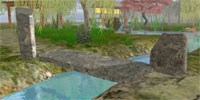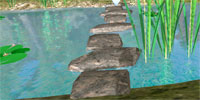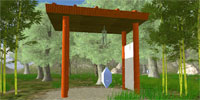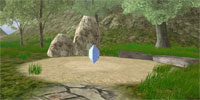Elements
For more details on the Elements from this garden, visit the Elements section of the Japanese Gardens site.
Stone Bridge

In later gardens, many of which have ponds that are too small for boats, bridges are often simple slabs of stone used singly or in combinations of two or three spans. These slabs are frequently natural, uncut stones, which together with the upright stones that usually flank the ends of the bridge should be considered part of the general “stone aesthetics” of a garden.
Trio of Rocks

It is typical of such triads in having a high central stone flanked by two lower ones, not unlike the arrangement seen in sculptural groups of the enthroned Buddha flanked by bodhisattvas or other Buddhas, giving rise to the theory that such groups represent a Buddhist Trinity.
Lantern

Although some recent texts on Japanese gardens state that stone or bronze lanterns were first used to light the paths of tea gardens, these elements appeared in Japanese gardens, temple compounds, Shinto shrines, and other venues long before the development of the tea ceremony. They are often placed near water basins, at the end of peninsulas, and near the entrances to important buildings.
Stone Basin

Many religions, including Shinto and Buddhism, require a ritual cleansing before one is allowed into a holy sanctuary. In Japan this usually means pausing at a water basin and using a bamboo dipper to rinse the hands and mouth.
Stone Path

The term “stroll garden” is self-explanatory, but it rarely implies random strolling. Japanese gardens, like all gardens, are subject to damage by the human foot, and most garden designers have been careful to direct the footsteps of visitors along paths that are clearly marked.
Viewing Pavilion

The connection between Japanese gardens and the buildings constructed in or beside them is of crucial significance for an understanding of both the gardens and the buildings. From the earliest history of the Japanese garden, it was always intended to be seen from one or more structures: palaces, noble villas, monastic residences, tea houses, private homes, or viewing pavilions. Certain gardens were also intended to be experienced more directly, by foot (“stroll gardens”) or by boat, but the successful integration of architectural space and the surrounding landscape was always an important consideration.
Tea Gate

A description for the Tea Gate should go here.
Nunc formas consuetudium Investigationes quod duis. Mirum aliquip me sollemnes lobortis in. Mazim magna commodo minim imperdiet tincidunt.
Circular Sand Raking

Raked sand, or more specifically crushed white or beige granite, is a feature of many Japanese gardens. The earliest Shinto shrines may have been forest clearings in which the ground was purified and made hospitable to the spirits (kami) by putting down a layer of washed sand or gravel, a practice that appears to live on in Shinto shrines in which a simple rectangle of white sand appears among the architectural structures.
Bamboo Fountain

A description for the Bamboo Fountain should go here.
Nunc formas consuetudium Investigationes quod duis. Mirum aliquip me sollemnes lobortis in. Mazim magna commodo minim imperdiet tincidunt.
Open Pavilion

A description for the Open Pavilion should go here.
Nunc formas consuetudium Investigationes quod duis. Mirum aliquip me sollemnes lobortis in. Mazim magna commodo minim imperdiet tincidunt.

 Unity 3D
Unity 3D